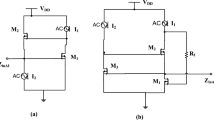Abstract
A 2.4 GHz rectifier operating in a region of low RF input power was developed. The rectifier has a cross-coupled bridge configuration and is driven by a differential RF input signal. Since a rectifier needs an RF signal higher than the threshold voltage of transistors, we introduced a pre-biasing circuit to compensate for the threshold voltage. A low-voltage digital circuit, subthreshold voltage regulator, and low-power level shifter were introduced for reducing the power consumption of the pre-biasing circuit and increasing the driving voltage for the switches at the same time. The circuit simulations revealed that the pre-biasing circuit was effective in a low RF input power region. However, the output voltage was degraded in a high power region. Then, we combined the pre-biased rectifier in parallel with a non-biased rectifier. Three types of rectifiers consisting of LC matching circuits, three-stage rectifier cells, and biasing circuits were designed and fabricated using a 0.18-μm mixed signal/RF CMOS process with one poly and six metal layers. The fabricated pre-biased rectifier operated in a region of RF input power of less than −15 dBm, while the non-biased rectifier could not operate in this region. The parallel combination of pre-biased and non-biased rectifiers effectively solved the drawback of the pre-biased rectifier in a high RF input power region.













Similar content being viewed by others
References
Le, T., Mayaram, K., & Fiez, T. (2008). Efficient far-field radio frequency energy harvesting for passively powered sensor networks. IEEE Journal of Solid-State Circuits, 43(5), 1287–1302.
Papotto, G., Carrara, F., & Palmisano, G. (2011). A 90-nm CMOS threshold-compensated RF energy harvester. IEEE Journal of Solid-State Circuits, 46(9), 1985–1997.
Takahagi, K., Matsushita, H., Iida, T., Ikebe, M., Amemiya, Y., & Sano, E. (2012). Low-power wake-up receiver with subthreshold CMOS circuits for wireless sensor networks. Analog Integrated Circuits and Signal Processing. doi:10.1007/s10470-012-9929-1.
Fiorini, P., Doms, I., Van Hoof, C., & Vullers, R. (2008). Micropower energy scavenging. In Proceedings of 34th ESSCIRC, Edinburgh (pp. 4–9).
Karthaus, U., & Fischer, M. (2003). Fully integrated passive UHF RFID transponder IC with 16.7-μW minimum RF input power. IEEE Journal of Solid-State Circuits, 38(10), 1602–1608.
Yao, Y., Wu, J., Shi, Y., & Dai, F. (2009). A fully integrated 900-MHz passive RFID transponder front end with novel zero-threshold RF-DC rectifier. IEEE Transactions on Industrial Electronics, 56(7), 2317–2325.
Nakamoto, H., Yamazaki, D., Yamamoto, T., Kurata, H., Yamada, S., Mukaida, K., et al. (2007). A passive UHF RF identification CMOS tag IC using ferroelectric RAM in 0.35-μm technology. IEEE Journal of Solid-State Circuits, 42(1), 101–110.
Kotani, K., Sasaki, A., & Ito, T. (2009). High-efficiency differential-drive CMOS rectifier for UHF RFIDs. IEEE Journal of Solid-State Circuits, 44(11), 3011–3018.
Umeda, T., Yoshida, H., Sekine, S., Fujita, Y., Suzuki, T., & Otaka, S. (2006). A 950-MHz rectifier circuit for sensor network tags with 10-m distance. IEEE Journal of Solid-State Circuits, 41(11), 35–41.
Lim, J., Cho, H., Cho, K., & Park, T. (2009). High sensitive RF-DC rectifier and ultra low power DC sensing circuit for waking up wireless system. In Asia-Pacific Microwave Conference, Singapore (pp. 237–240).
Takahagi, K., Otsu, Y., & Sano, E. (2012). 2.45 GHz high-gain electrically small antenna with composite right/left-handed ladder structure. IET. Electronics Letters, 48(16), 971–972.
Iida, T., Asai, T., Sano, E., & Amemiya, Y. (2009). Offset cancellation with subthreshold-operated feedback circuit for fully differential amplifiers. In Proceedings of The 16th IEEE International Conference on Electronics, Circuits, and Systems, Tunisia (pp. 140–143).
Osaki, Y., Hirose, T., Kuroki, N., & Numa, M. (2012). A low-power level shifter with logic error correction for extremely low-voltage digital CMOS LSIs. IEEE Journal of Solid-State Circuits, 47(7), 1776–1783.
Acknowledgments
This work was partially supported by SCOPE and by VDEC in collaboration with Cadence Design Systems, Inc. and Agilent Technologies Japan, Ltd.
Author information
Authors and Affiliations
Corresponding author
Rights and permissions
About this article
Cite this article
Otsu, Y., Kubo, K., Ikebe, M. et al. Design and fabrication of 2.4 GHz pre-biased rectifier. Analog Integr Circ Sig Process 79, 301–307 (2014). https://doi.org/10.1007/s10470-014-0256-6
Received:
Revised:
Accepted:
Published:
Issue Date:
DOI: https://doi.org/10.1007/s10470-014-0256-6




